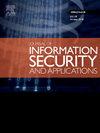Intelligent detection framework for IoT-botnet detection: DBN-RNN with improved feature set
IF 3.8
2区 计算机科学
Q2 COMPUTER SCIENCE, INFORMATION SYSTEMS
Journal of Information Security and Applications
Pub Date : 2025-01-12
DOI:10.1016/j.jisa.2024.103961
引用次数: 0
Abstract
The pervasive adoption of IoT devices has significantly enhanced connectivity but also introduced vulnerabilities, particularly through IoT botnets, which exploit compromised devices for large-scale attacks. Current detection methods, although effective, often face challenges in accuracy. This work proposes a new framework for IoT botnet detection utilizing an optimized hybrid classification technique. The framework comprises two primary phases: feature extraction and attack detection. Initially, various features including statistical measures, higher-order statistics, improved correlation-based insights, and flow-based characteristics are extracted from IoT network data. Notably, the approach enhances traditional correlation analysis by weighting data points based on proximity, refining the detection of complex relationships crucial for identifying botnet behaviors. To identify attacks, the system uses a hybrid classifier that integrates an Improved Deep Belief Network (IDBN) with a Recurrent Neural Network (RNN). The Improved DBN incorporates batch normalization and dropout layers, along with a modified Gumbel softmax activation function, to bolster its robustness against noisy data and prevent overfitting, while the RNN excels in sequential data analysis, capturing temporal dependencies within IoT traffic. Additionally, Self-Adaptive Beluga Whale Optimization (SA-BWO) is utilized for optimizing RNN weights, to enhance the accuracy for detection through adaptive parameter tuning. Experimental validation demonstrates the framework's superior performance in detecting IoT botnet activities, surpassing conventional methods in accuracy and resilience.
求助全文
约1分钟内获得全文
求助全文
来源期刊

Journal of Information Security and Applications
Computer Science-Computer Networks and Communications
CiteScore
10.90
自引率
5.40%
发文量
206
审稿时长
56 days
期刊介绍:
Journal of Information Security and Applications (JISA) focuses on the original research and practice-driven applications with relevance to information security and applications. JISA provides a common linkage between a vibrant scientific and research community and industry professionals by offering a clear view on modern problems and challenges in information security, as well as identifying promising scientific and "best-practice" solutions. JISA issues offer a balance between original research work and innovative industrial approaches by internationally renowned information security experts and researchers.
 求助内容:
求助内容: 应助结果提醒方式:
应助结果提醒方式:


